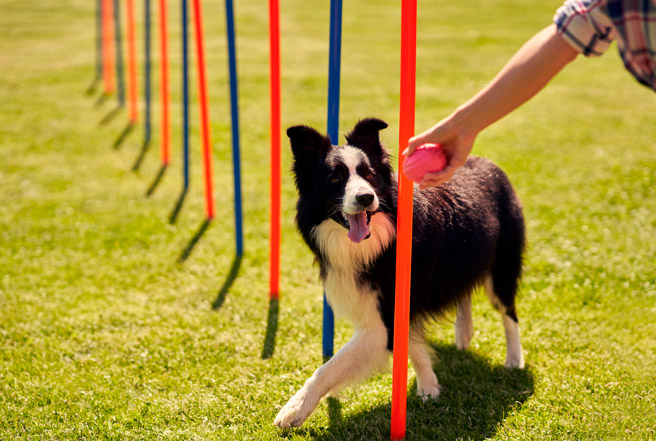“The heat is on!” – Keeping cool dogs on hot days
Summer looks like it might be arriving. The weather forecast is showing some spectacular summer weather is on its way and this has brought a smile to many faces. Nothing is better than being able to spend time outside with our dogs in the sunshine. However, it can come at a price. Even slightly warm weather can seriously impact on our dogs’ health and welfare and it’s worth being aware of the risks and how we can best manage our dogs to keep them safe, happy and healthy! Heatstroke is a particular concern for our dogs as temperatures rise, because dogs don’t’ sweat and cool themselves in the same way that we (and other species like horses!) do. This means that we often must provide opportunities for “active cooling” or simply manage them in a way to help reduce the risk of exposure to excess heat. Here are some of our top tips to help keep your dog cool as the temperature rises;
1. While exercise is important for the health and fitness of your dog, don’t feel you need to do your regular walks at their regular times, especially if it is particularly hot and/or sunny. Many dogs in the UK never get a chance to gradually acclimatise to warmer weather, which can make exercising them in higher temperatures potentially dangerous. Consider exercising early in the morning and/or late in the evening when it is cooler and much safer. Some dogs might even refuse to walk or exercise in the heat, so don’t force them and remember the surfaces they might be walking on – pavements, footpaths and road surfaces can all become surprisingly hot.
2. Be careful when travelling. Even in an air-conditioned car, your dog might not get the benefit, so it’s worth keeping a careful eye on your dog when moving. Air flow via open windows and roof vents can make a huge difference but don’t be tempted to let your dog hang their head out of an open window; remember that legally dogs should be secured in a moving vehicle and the risk of injury or escape is significant. Also consider shading your dog’s travelling area and providing water during the journey in a non-spill bowl or even travel bottle so that water is always available.
3. Provide cooling opportunities for your dog at home and in the garden (and these can be fun too!) My own dogs have a small paddling pool that we set up in their kennel run area, so that on hot days, they can bask, paddle, wallow, play with their toys or simply stand with their paws in the water. We also have cooling mats laid out in the house, so they can lie on these if they want to; these can be purchased from a lot of pet shops and are relatively inexpensive. Providing shaded areas can also help your dog to make choices where they rest and relax. Needless-to-say, your dog should always have fresh, clean drinking water available.
4. Remember that certain breeds of dog (especially the brachycephalic breeds like pugs, French bulldogs and bulldogs) are more at risk of heat stress and heatstroke because they cannot cool themselves by panting as effectively as some other breeds. Also, dogs carrying excess weight, older dogs and even very young dogs often have a reduced ability to deal with heat, so monitor them carefully and keep them safe!
5. Remember that parked cars, even in the shade can heat up surprisingly quickly. Every year, sadly, dogs die in parked cars. Opening car windows a tiny bit actually has very little cooling effect, so consider carefully about taking your dog with you if you need to leave them in a parked car that you cannot securely leave in the shade and with the doors/window/boot wide open. For many people who compete in canine sports, they have impressive cooling set-ups in their vehicles including battery operated fans, temperature monitors, heat reflective coverings and other strategies to keep their dogs cool even in a vehicle, although these tend to be specialised adaptations and are certainly not standard in most passenger cars. If in doubt, don’t risk leaving your dog in a parked, locked car, even for “just a minute”.
6. Be aware! Plan and monitor the weather forecast in advance if you are travelling or thinking about doing activities with your dog. Granted, forecasts are often not perfectly accurate, but it is better to be prepared than not! It is also worth knowing what is “normal” for your own dog by regularly monitoring their body temperature. This is a good health monitoring strategy and is also useful to monitor how they cope with warmer weather. One of my own dogs has a specialised microchip that holds not just her microchip number but also tells me her body temperature! I find this a great way to monitor her in both warm and cold weather.
7. If you do suspect that your dog (or someone else’s) is suffering from heatstroke (the symptoms of which can include; excessive panting, drooling, vomiting/diarrhoea, glassy eyes, staggering, collapsing and in extreme cases, fitting), you MUST actively cool the animal as quickly as possible. This typically takes the form of dousing the animal repeatedly in cool water for several minutes and seeking immediate veterinary help. Active cooling using water and cool air if possible is critical to give the dog the best chance of survival without other consequences. As with so many situations however, prevention is always better than cure.
8. Keep up to date with the current science about managing your dog in warm weather by visiting the “Hot Dogs Research” blog either on twitter (@Hot_Dogs_research) or at https://heatstroke.dog/ .At Skinner’s we would love to see how you are keeping your dog cool in the summer weather. Share your photos of your dogs keeping cool on social media and tag us in them!



